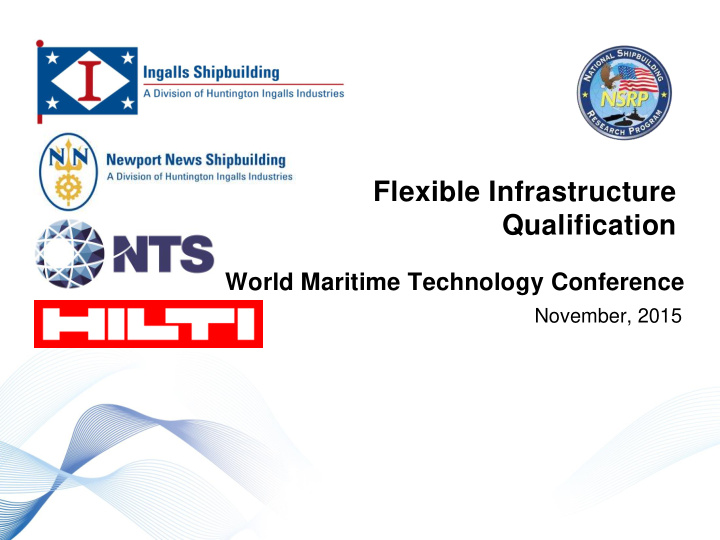



Flexible Infrastructure Qualification World Maritime Technology Conference November, 2015
Agenda • Project Background/Overview • Technical Approach • Shock Testing Review • Next Steps 2
Team Members • Ingalls Shipbuilding – Project Lead – Sean Murphy, Sara Trawick, Davida Cunningham, Adam McDowell, Ron McClellan, John Walks • Newport News Shipbuilding – Glenn Dorsey, Don Slack, Matt Tilley • NTS – Mike Poslusny • Hilti – Jessica Galassie • SCRA – Mary Saady, Project Manager • NASSCO – Dan Sfiligoi, Project Technical Representative 3
What Is Flexible Infrastructure/Benefits • Flexible Infrastructure is a system of systems that will provide capabilities for rapid space changes without the use of “hot work”. Benefits: • Maximizes time for technology development prior to equipment installation during construction outfitting • Eliminates cost and schedule impacts associated with the traditional conflicts from re-work and change orders during new construction • Eases compartment reconfiguration to support changing missions and lifecycle refresh of electronic components 4
Flexible Infrastructure Design Elements • Deck Track System – 3 heights for various applications • 12” – high track • 9” – mid track • 6” – low track • Bulkhead Track System • Overhead Track System • Portable Stanchions and Bulkheads • Under Deck Ventilation – Used with 12” Deck Track System and overhead track • Flexible Lighting • Flexible Power Design elements can be individually integrated 5
FI Component Overview EQUIPMENT ENCLOSURE EQUIPMENT ENCLOSURE TRACK FITTING TRACK FITTING DECK TRACK DECK TRACK OVERHEAD TRACK SYSTEM BULKHEAD TRACK SYSTEM WELDED STUD WELDED STUD SHIP STRUCTURE SHIP STRUCTURE DECK TRACK SYSTEM PORTABLE STANCHIONS ATTACH TO OVERHEAD TRACK WITH A STEEL SLIP JOINT MOUNTED TO THE OVERHEAD TRACK. Bulkhead Track MEDIUM DUTY FITTINGS LIGHT DUTY FITTING 6
Goals • The project goals are to: – Qualify all structural elements of FI to demonstrate compliance with shock and vibration requirements of Navy surface combatants and amphibious assault ships – Qualify as many non-structural elements of FI to the same shock and vibration requirements as budget allows • Project is success driven • Assumes timely approval of test procedures by NAVSEA • Assumes passing of all tested flexible infrastructure elements • Assumes timely approval and qualification of test results by NAVSEA 7
Key Elements of Test • Test Classification and Details • Test Specimens • Acceptance Criteria 8
Shock Qualification • Previous FI qualification for Carrier Gallery Deck installation – Carrier Gallery Deck qualification requires a test at 8-10 Hz • Most of our possible FI installation locations are deck mounted. – Require a qualification test at 25 Hz (Covers deck mounted requirements for all Surface Combatants and Amphibs) Hull, Deck, & Shell • Some bulkheads are hull mounted. Mounting Locations (Main Watertight Bulkheads, 40 per Foot Bulkhead) NAVSEA 0908-LP-000-3010 Rev. A – Require a qualification test above 37 and MIL-S-901D Hz 9
Test Classification and Details Test Specification, Classification and Details • Applicable Specification: MIL-S-901D • Test Category: Heavy Weight • Mounting Locations: Deck • Shipboard Mounting Plane Represented During Test: Back Mounted or Overhead •Mounting Orientation of item relative to ship’s fore -and-aft axis: Vertical Axis Specified 10
Shock Testing • Two barges were tested – Five pedestals, bulkhead track setups – Overhead track setup • Five shots, per MIL-S-901D, with one to simulate a rotation of the overhead track • Testing took place at NTS in Rustburg, VA the week of July 6-10, 2015 11
Pedestal Layout on Barges Barge 1 Barge 2
Example: Pedestal 1, Side 4 – Before Shots
Pedestal 1, Side 4 – After Shots
General Failure Criteria • Deformation or twisting of mount or attachment method is not considered a failure. • For overhead track, the following instances are considered failures: – Dummy mass separation from the track – Light duty fitting separation from the track – Shearing of the bolts or studs – Any breakage of flat bar • For bulkhead track, the following instances are considered failures: – Dummy mass separation from the track – Saddle nut separation from the track – Shearing of the bolts or studs • Slippage of the saddle nuts of one inch or less on vertical track pieces shall not be considered a failure.
Test Summary • Five barge shots performed and various distances • The majority of the components survived
Bulkhead track failures • Bulkhead track with dummy masses that failed • All dummy masses failed by detaching itself from the track.
Stud and Track failures
Pipe Hanger Failure
Next Steps • Have a working session and shock brief with Tech Warrant Holders – Discuss testing • Results • Qualification Process • Development of the Vibration Test Procedure • Vibration Testing • Report Generation (both Shock and Vibration) • Implementation plan for ships 20
Recommend
More recommend